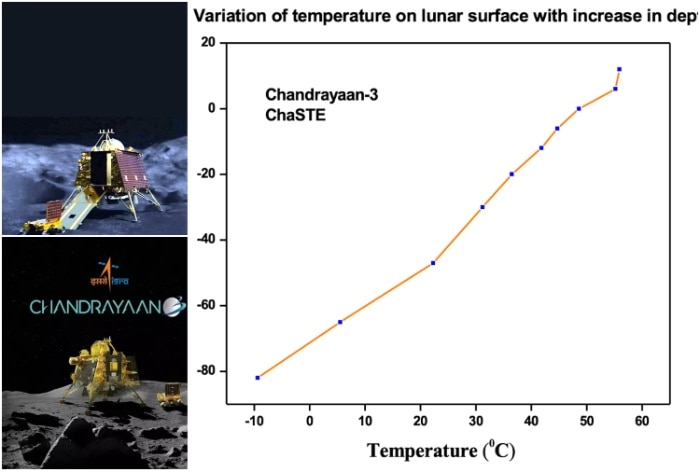ISRO said ChaSTE payload aboard Vikram lander of the Chandrayaan-3 measured the temperature profile of the lunar topsoil around the pole to understand the thermal behaviour of the Moon’s surface.

New Delhi: The Chandra’s Surface Thermophysical Experiment or ‘ChaSTE payload aboard the Chandrayaan-3’s Vikram lander has measured temperatures of the lunar surface and observed variations, ISRO said on Sunday as they released a graph of the readings sent back by ChaSTE.
ISRO said ChaSTE measured the temperature profile of the lunar topsoil around the pole to understand the thermal behaviour of the Moon’s surface.
“Here are the first observations from the ChaSTE payload onboard Vikram Lander. ChaSTE (Chandra’s Surface Thermophysical Experiment) measures the temperature profile of the lunar topsoil around the pole to understand the thermal behaviour of the moon’s surface,” ISRO said in an update X, formerly Twitter.
Speaking about the graphic illustration, ISRO scientist B H M Darukesha told news agency PTI: “We all believed that the temperature could be somewhere around 20 degree centigrade to 30 degree centigrade on the surface but it is 70 degree centigrade. This is surprisingly higher than what we had expected.”
Chandrayaan-3 Mission:
Here are the first observations from the ChaSTE payload onboard Vikram Lander.ChaSTE (Chandra’s Surface Thermophysical Experiment) measures the temperature profile of the lunar topsoil around the pole, to understand the thermal behaviour of the moon’s… pic.twitter.com/VZ1cjWHTnd
— ISRO (@isro) August 27, 2023
How ChaSTE works?
According to ISRO the ChaSTE payload is equipped with a temperature sensing probe armed with a controlled penetration mechanism which is capable of reaching a depth of 10 centimetres beneath the moon’s surface.
“The probe is fitted with 10 individual temperature sensors. The presented graph illustrates the temperature variations of the lunar surface/near-surface at various depths, as recorded during the probe’s penetration. This is the first such profile for the lunar south pole. Detailed observations are underway,” the national space agency said in a statement.
Further explaining the workings of the state-of-the-art payload and the measurements it has performed on the moon’s surface so far, ISRO scientist Darukesha said: “When we go two to three centimetres inside the Earth, we hardly see two to three degree centigrade variation whereas there (in Moon), it is about 50 degree centigrade variation. This is something interesting.”
The temperature dips to minus 10 degree Celsius below the lunar surface, the senior scientist said, adding that the variation is from 70 degree Celsius to minus 10 degree Celsius.
ChaSTE payload was developed by a team led by the Space Physics Laboratory (SPL) of the space agency’s Vikram Sarabhai Space Centre (VSSC) in collaboration with Physical Research Laboratory (PRL), Ahmedabad, ISRO informed.
Chandrayaan-3: India’s tryst with history
India on August 23 scripted history as ISRO’s ambitious third Moon mission Chandrayaan-3 touched down on the lunar surface, making it only the fourth country to accomplish the feat, and first to reach the uncharted south pole of Earth’s only natural satellite.
Prime Minister Narendra Modi on Saturday announced that the spot where Chandrayaan-3 Vikram lander touched down would henceforth be called ‘Shiv Shakti Point’, and the site where the Chandrayaan-2 lander crash-landed on the Moon’s surface in 2019 would be known as ‘Tiranga Point’.
Besides, August 23 would be celebrated as ‘National Space Day’ to mark the day when Chandrayaan-3 lander touched down on the lunar surface, Modi said.
(With PTI inputs)

Don’t Miss Out on the Latest Updates.
Subscribe to Our Newsletter Today!

